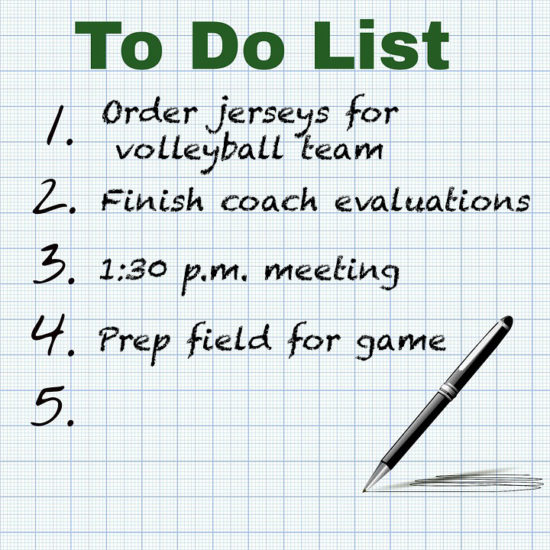11 ways to revamp your to-do list and get more done
Daily to-do lists are a time-honored technique for organizing your tasks in an effort to be as efficient as possible. Since more responsibilities and requirements are added every month to an athletic director’s plate, it’s vital that you rethink how you put together and use your to-do list.
 You probably are working as hard as you can, so increasing the intensity of your efforts can’t be the answer to accomplishing more during any given day. And, rethinking how you utilize your to-do list doesn’t mean that you should abandon this technique. But, perhaps there are a few ideas that make it more functional.
You probably are working as hard as you can, so increasing the intensity of your efforts can’t be the answer to accomplishing more during any given day. And, rethinking how you utilize your to-do list doesn’t mean that you should abandon this technique. But, perhaps there are a few ideas that make it more functional.
1. Find your number.
Sometimes, too few or too many items on a to-do list are counter-productive. A low number of items allows you to accomplish everything with time to spare while a lengthy, unmanageable list leaves you with a feeling of disappointment at the end of the day when you don’t get enough done. What’s the right number for your list?
2. Establish priorities.
Realize that not all items included on your list are of equal importance or take the same amount of time to complete. For example, if you have some things that only take a minute or two to complete, you obviously can expand your list beyond 10 standard daily items. It’s also important, therefore, to consider how long an item takes to complete and not simply how many things are on your list to accomplish.
3. Be realistic.
Always keep in mind that you never have enough time to finish everything you want or should accomplish in a given day. An athletic director simply has too many responsibilities and tasks to complete, and this has nothing to do with how many items you put on your list.
4. Quick start or not?
Determine whether you’re a morning person, and seriously consider this when you try to determine the order to tackle the items on your list. If you aren’t a morning person, you may not want to try to complete anything that takes a higher level of thinking — such as composing an answer to a challenging problem as your first job of the day.
Improve your to-do list by establishing priorities and making realistic expectations for your day.
5. Working around the school schedule.
Also understand and use your school’s daily schedule to your best advantage. Before classes start in the morning, for example, represents a convenient time for students and coaches to stop by your office with questions and ask for help. Plan things during this time in which interruptions don’t affect the work and are easy to pick up again after your visitors leave. Lunch periods and the time immediately after the conclusion of the school day are also prime times when you are going to be interrupted while helping students and coaches.
6. Controlling a crisis.
Be prepared to reorder your to-do list if you suddenly have to deal with a crisis or a problem. A crisis rarely comes with advanced notice so you need to stop immediately and consider what tasks can be moved to tomorrow or later in the week. One way to avoid having multiple crises is to do as many proactive things as possible.
7. Plan the night before.
Consider preparing your to-do list at the conclusion of your day or later in the evening at home. Even on your best days, there are items you didn’t have a chance to finish and need to be included on the list for the following day. If you prepare your to-do list after concluding your day, you have an accurate idea of what wasn’t completed. And, new items that need attention for the next day are fresh in your head.
8. Prioritize: Part II.
Don’t automatically move items that haven’t been completed at the end of the day to the top slots on the following day’s list. There may be other items that have a higher level of importance and need to be placed near the top of your list. The to-do list constantly evolves as your day and week develop.
9. Type it out.
Consider typing your to-do list using Word or Excel. This makes your list easier to read and allows for easy revisions with a simple cut and paste. Print out the list to cross items off if that works for you or highlight the completed tasks in a contrasting color on your computer.
10. Make it work-accessible.
Take one additional creative step if your use Word or Excel to create your to-do list send it via an email attachment to your office computer. Have you ever created your list in the evening and forgotten to put it into your briefcase, or perhaps you misplaced it? Emailing this important document from home eliminates this unfortunate situation.
11. Filing the list.
Think about filing your daily to-do lists in their Word or Excel format in a hard-drive folder. Provided that you put a date on the top of each daily list, you have a handy reference of when a task is completed. These documents help when you plan your monthly and seasonal plans for the following year.
Scribbling a few notes on a scrap piece of paper still may work as reminders to get everything done. But, fine-tune your approach and watch your efficiency increase. Add updating your to-do list techniques to your document for tomorrow and prepare to get more done.





